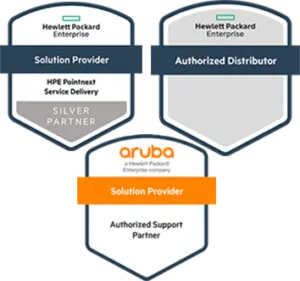
Enhancing Steelmaking Processes with HPE hybrid Cloud
Data-driven solutions have transformed the manufacturing industries. While using data to improve production methods is a surefire way for steel producers to stay competitive, it can only be challenging with the right strategy. Fortunately, using data to improve the steel production process is more straightforward than it appears; all required is the proper tool setup and expertise.
Steel Authority of India Limited’s (SAIL) capacity to produce steel has increased. It contributes to the expansion of India’s primary industries and infrastructure. The company modernized its core systems and paved the way for the switch to SAP S/4HANA by implementing a hybrid cloud platform at its Bokaro plant. Crude steel production is now more than doubling what SAIL had hoped for. It has contributed to the economic development of India while positioning the company for long-term growth.
Producing the Steel That Supports India’s Infrastructure

SAIL is one of the world’s largest raw steel producers, with an annual output of more than 17 million tons and a workforce of more than 60,000. The company’s vision is to become a reputable global corporation and a leader in the Indian steel industry, focusing on quality, productivity, profitability, and customer satisfaction. Given the importance of the company’s products to India’s manufacturing, automobile, construction, and other industries, its manufacturing facilities are an essential component of the infrastructure supporting the country’s ongoing operations and long-term growth.
SAIL’s unique steel plants in Rourkela, Bhilai, Durgapur, Bokaro, and Burnpur produce 50 products using 500 steel grades. Because it serves as the industrial hub for the numerous cities where it operates, the company’s operations are critical to entire communities. As a result, India’s Ministry of Steel closely monitors the government-owned SAIL to ensure productivity.
Solution
- HPE GreenLake platform
- HPE Superdome Flex 280 server
- HPE Primera 650 storage
- HPE ProLiant DL325 and ProLiant DL380 servers
- HPE StoreOnce systems
- HPE MSA SAN storage
- Aruba CX 8360 Switch Series
- Intel Xeon Scalable processors
Twelve Years of Automation Success
To achieve ongoing growth and expansion through new joint ventures, SAIL has made significant investments in automation and other efficiency improvements. It improved its enterprise resource planning (ERP) in 2010 with a large SAP deployment on Itanium-based HP-UX and HPE Integrity servers. Hewlett-Packard Enterprise provided implementation and ongoing support. “That was a wonderful journey for us because we were able to achieve zero downtime,” says SAIL’s Bokaro plant manager. The system’s robustness and high-availability architecture resulted in no unplanned system downtime in 12 years, thanks to HP/excellent HPE’s support.
SAIL eventually implemented nearly every SAP function. It strengthened the platform to support logistics, marketing, preventive maintenance, production planning, supplier relationship management, finance, customer relationship management, and other functions. As India’s industrialization progressed, the capacity for steel production expanded. It aided in meeting the country’s rising domestic demand while supporting critical manufacturing and infrastructure projects.
When Growth Poses Its Challenges
As SAIL’s systems aged, they became more difficult to maintain. Increasing user expectations introduced new challenges. Employees pressure IT to perform better, enable large-scale data management, and introduce new applications such as automation and integration with plant equipment to implement sophisticated data-driven applications.
Because the IT environment had become so complex, the end-of-month and end-of-quarter reconciliation reports took three to four days. According to Singh, performance was a significant concern. “This environment hosts all of the organization’s business applications. We are a 24-hour operation when you can’t afford to shut down the entire system for maintenance.
As SAIL’s data needs grew, its backup architecture became a bottleneck because the system could no longer complete critical backups within the designated five-hour overnight window. These constraints jeopardized the company’s ability to back up more than 35 TB of critical SAP operational data, including 4.5 TB of SAP ERP Central Component data.
These requirements, combined with the fact that HP-UX was approaching the end of its useful life, prompted SAIL’s IT team to investigate options for updating the organization’s entire architecture—to consolidate all systems and legacy applications onto a single SAP S4/HANA platform.
Laying the Foundation for the Future
SAIL considered options for its market strategy, beginning with an upgrade at its Bokaro facility in the country’s centre. To lay the groundwork for a future company-wide migration to the SAP S4/HANA platform, it was necessary to ensure that the process would not disrupt business operations while allowing legacy applications to be migrated. “We didn’t have the luxury of stopping the system and migrating to a new platform,” Singh explains. The migration had to be transparent and seamless for users to notice no differences.
After considering several options, the SAIL team chose the HPE GreenLake edge-to-cloud platform and an HPE Superdome Flex 280 server, HPE Primera storage systems, and HPE StoreOnce systems. According to Singh, HPE GreenLake provided the capacity and scalability that allowed us to experiment with a cloud-based platform on-site while still utilizing our existing data centre infrastructure. With VMware® virtual machines running on Red Hat® Enterprise Linux®, the application infrastructure can be as flexible and scalable as needed, allowing SAIL to innovate and roll out new services quickly.
A Smooth Migration
After months of careful planning, they were allowed the SAIL and HPE teams to prepare for the live migration. It was smoothly implemented over a long weekend with a national holiday. According to Singh, applications were up and running on the new platform when users arrived at work on Monday, which was “a very nice experience for us.” Only one aspect of the implementation was application migration to new systems.
SAIL also implemented a new data storage architecture to improve performance and data scalability and upgraded its core network from 1 Gbps to 10 Gbps. It improved the performance and user experience of data-intensive applications.
Increased bandwidth also enabled a significant upgrade in SAIL’s data storage capacity and backup procedures. These were moved from obsolete tape drives to an operational HPE Primera 650 storage array, managed with Veeam backup software and HPE StoreOnce systems to minimize and manage data flows.
No Longer Held Back by the Weight of Legacy
Because of the HPE GreenLake environment switch, reporting now takes only a few hours, and backups take only a few minutes. The new architecture has also reduced the environmental impact of the data centre, allowing SAIL to meet its corporate sustainability goals while using less energy.
Furthermore, the new environment removed the barriers that prevented the company from utilizing the cloud-based programs and services required to run a modern, data-driven enterprise.
SAIL users report better results because they use cutting-edge data-driven analytics capabilities. The new virtualized architecture allows the company’s technical team to respond more quickly to changing business requirements while saving time and money.
The company is discussing similar migrations at other locations to consolidate its entire operational infrastructure onto the SAP S4/HANA platform by 2028.
A Robust New Architecture for Future Growth
SAIL’s new environment, which employs various HPE and partner technologies, was implemented with the help of Advisory and Professional Services for the transformation. This environment is powered by a modular HPE Superdome Flex 280 compute infrastructure with 3rd Gen Intel® Xeon Scalable processors. SAIL chose HPE Superdome Flex 280 because it has enough expandable CPU, memory, and storage to support its current needs and significant future expansion.
Final Thought
Overall, harnessing data is essential for any steel production process. By using predictive analytics in combination with real-time measurements, companies can get a comprehensive view of the entire process and make more informed decisions. Not only will this help improve product quality, but it will also reduce production time and costs while ensuring that safety regulations are followed. In the future, we should expect to see even more technological advances that will further streamline steel production processes and allow companies to stay competitive and efficient.
HPE ProLiant servers, storage, and networking solutions are all available from ICT Distribution Bangladesh. Our staff will provide our customers with the best service and assistance possible. So, what’s holding you back? Syed Adnan, our country manager, can be reached at syed.adnan@ictdistribution.net.
Latest Posts



Comparing HPE Storage Server Models: Which One Suits Your Needs?

How HPE’s Innovations Are Shaping the Next Decade of Technology

Beyond Antivirus: Why Kaspersky Total Security is Your 2024 Digital Guardian


Comparing HPE Storage Server Models: Which One Suits Your Needs?



